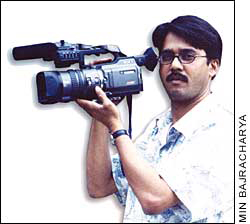 When filmmaker Dhurba Basnet decided to join a group of journalists on a trip to Rukum, Rolpa and Jajarkot last year, the 37-year-old didn't imagine that his work in the epicentre of the Maoist insurgency, would result in a powerful, provocative film.
When filmmaker Dhurba Basnet decided to join a group of journalists on a trip to Rukum, Rolpa and Jajarkot last year, the 37-year-old didn't imagine that his work in the epicentre of the Maoist insurgency, would result in a powerful, provocative film. Dhurba's The Killing Terraces, a 26-minute documentary, was recently screened at Mountain Film Telluride in Colorado, and travels on to the Banff Mountain Film Festival in Canada this autumn. Australian SBS TV recently bought the rights to the film, which has won critical acclaim and been described as a powerful anti-war film depicting the futility of violence and the human suffering it unleashes.

Terraces was the opening film at Film South Asia 2001 in Kathmandu, and exposes the roots of the Maoist crisis. Although it was shot two years ago, before the insurgency moved into fast-forward, it delves deeply into the neglect, disinterest and disillusionment that fed the frustrations that contributed to the rise of Maoism. Now what worries many viewers is that things are actually much worse in the midwest, and that many Maoist prisoners, villagers, and security personnel in the film have since been killed.
"The response has been overwhelming. I'm just glad that the film has been able to provide viewers in Nepal and abroad an insight into the roots of the Maoist problem," says the soft-spoken Dhurba modestly. "It is a film about war, but the underlying message is of the need for peace."
Dhurba is not just sitting back and basking in his success. He has just finished another documentary on people living with HIV for the UK-based Television Trust for the Environment (TVE), which was shown at a global AIDS conference in Barcelona this week.
A graduate in sociology, Dhurba was born in Chitwan, and started out as a trainee cameraman at Nepal Television. In 1994, he helped set up Ankhijhyal, a popular fortnightly television magazine with investigative reports and documentaries on development and social issues produced by the Nepal Forum of Environmental Journalists.
Dhurba has travelled through 70 of Nepal's 75 districts, and he likes his job more and more, "mainly because digital cameras are getting lighter," he jokes. But there have been moments when Dhurba has wondered why he ever became a filmmaker. In 1995, while lugging his heavy camera equipment up over the 5,300 m Larkya Pass between the Buri Gandaki and Manang valleys, he was struck with acute mountain sickness. And while fighting off the effects of altitude, he was hit by typhoid. He was sure his time had come. Fortunately for us, just as they were running low on food, Dhurba and his crew were rescued by helicopter.


